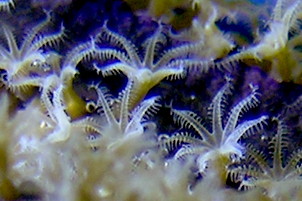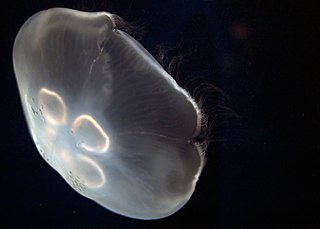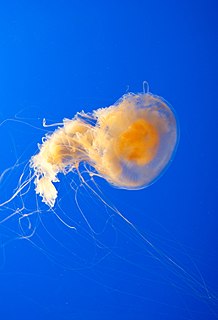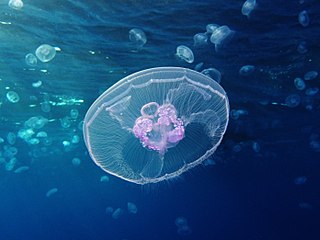
Cnidaria is a phylum under kingdom Animalia containing over 11,000 species of aquatic animals found both in freshwater and marine environments, predominantly the latter.

A polyp in zoology is one of two forms found in the Phylum Cnidaria, the other being the medusa. Polyps are roughly cylindrical in shape and elongated at the axis of the vase-shaped body. In solitary polyps, the aboral end is attached to the substrate by means of a disc-like holdfast called a pedal disc, while in colonies of polyps it is connected to other polyps, either directly or indirectly. The oral end contains the mouth, and is surrounded by a circlet of tentacles.

Jellyfish and sea jellies are the informal common names given to the medusa-phase of certain gelatinous members of the subphylum Medusozoa, a major part of the phylum Cnidaria. Jellyfish are mainly free-swimming marine animals with umbrella-shaped bells and trailing tentacles, although a few are anchored to the seabed by stalks rather than being mobile. The bell can pulsate to provide propulsion for highly efficient locomotion. The tentacles are armed with stinging cells and may be used to capture prey and defend against predators. Jellyfish have a complex life cycle; the medusa is normally the sexual phase, which produces planula larva that disperse widely and enter a sedentary polyp phase before reaching sexual maturity.

The Scyphozoa are an exclusively marine class of the phylum Cnidaria, referred to as the true jellyfish.

Rhopalia are small sensory structures of certain Scyphozoan and Cubozoan species.

Medusozoa is a clade in the phylum Cnidaria, and is often considered a subphylum. It includes the classes Hydrozoa, Scyphozoa, Staurozoa and Cubozoa, and possibly the parasitic Polypodiozoa. Medusozoans are distinguished by having a medusa stage in their often complex life cycle, a medusa typically being an umbrella-shaped body with stinging tentacles around the edge. With the exception of some Hydrozoa, all are called jellyfish in their free-swimming medusa phase.

Semaeostomeae is an order of large jellyfish characterized by four long, frilly oral arms flanking their quadrate mouths. The umbrella is domed with scalloped margins, and the gastrovascular system consists of four unbranched pouches radiating outwards from the central stomach; no ring canal is present. They usually possess eight tentacles; four are per-radical and four are inter-radical.

Pelagia noctiluca is a jellyfish in the family Pelagiidae and the only currently recognized species in its genus. It is typically known in English as the mauve stinger, but other common names are purple-striped jelly, purple stinger, purple people eater, purple jellyfish, luminous jellyfish and night-light jellyfish. In Greek, pelagia means "(she) of the sea", from pelagos "sea, open sea"; in Latin nocti is the combining form of nox "night"" and lux means light; thus, Pelagia noctiluca can be described as a marine organism with the ability to glow in the dark (bioluminescence). It is found worldwide in tropical and warm temperate seas, although it is suspected that records outside the North Atlantic region, which includes the Mediterranean and Gulf of Mexico, represent closely related but currently unrecognized species.

Phacellophora camtschatica, commonly known as the fried egg jellyfish or egg-yolk jellyfish, is a very large jellyfish in the family Phacellophoridae. This species can be easily identified by the yellow coloration in the center of its body which closely resembles an egg yolk, hence how it got its common name. Some individuals can have a bell close to 60 cm (2 ft) in diameter, and most individuals have 16 clusters of up to a few dozen tentacles, each up to 6 m (20 ft) long. A smaller jellyfish, Cotylorhiza tuberculata, typically found in warmer water, particularly in the Mediterranean Sea, is also popularly called a fried egg jellyfish. Also, P. camtschatica is sometimes confused with the Lion's mane jellyfish.

Discomedusae is a subclass of jellyfish in the class Scyphozoa. It is the sister taxon of Coronamedusae. Discomedusae contains about 155 named species and there are likely to be many more as yet undescribed. Jellyfish in this subclass are much more likely to have swarming events or form blooms than those in Coronamedusae. Discomedusae consists of two orders, Rhizostomae and Semaeostomeae.

Cotylorhiza is a genus of true jellyfish from the family Cepheidae. The genus is found in the central-east Atlantic, Mediterranean, and western Indian Ocean.

Chrysaora hysoscella, the compass jellyfish, is a common species of jellyfish that inhabits coastal waters in temperate regions of the northeastern Atlantic Ocean, including the North Sea and Mediterranean Sea. In the past it was also recorded in the southeastern Atlantic, including South Africa, but this was caused by confusion with close relatives; C. africana, C. fulgida and an undescribed species tentatively referred to as "C. agulhensis".

Aurelia is a genus of scyphozoan jellyfish, commonly called moon jellies. There are currently 25 accepted species and many that are still not formally described.

Cyanea is a genus of jellyfish, primarily found in northern waters of the Atlantic and Pacific Oceans and southern Pacific waters of Australia and New Zealand, there are also several boreal, polar, tropical and sub-tropical species. Commonly found in and associated with rivers and fjords. The same genus name has been given to a genus of plants of the Hawaiian lobelioids, an example of a parahomonym.
Drymonema is a genus of true jellyfish, placed in its own family, the Drymonematidae. There are three species: Drymonema dalmatinum, Drymonema gorgo, and Drymonema larsoni, which are found in the Gulf of Mexico, Atlantic Ocean and Mediterranean Sea.

The helmet jellyfish is a luminescent, red-colored jellyfish of the deep sea, belonging to the order Coronatae of the phylum Cnidaria. It is the only species in the monotypic genus Periphylla. They are the only known scyphozoan to undergo sexual propagation that lacks a planula stage. Not only is their reproductive cycle unique, so are their living conditions. They are found in deeper parts of the ocean due to them being photophobic.

Rhopilema verrilli, or mushroom cap jellyfish, is a species of jellyfish in the family Rhizostomatidae. They are cnidarian invertebrates distinguished by their mushroom-shaped medusae. The species does not have any tentacles; however, they still have stinging cells, called nematocysts, within their bells, which can produce mild stings to humans.

Sanderia malayensis is a species of jellyfish in the family Pelagiidae, native to the tropical Indo-Pacific. It has a complex life cycle and is thought to be venomous and to have caused injuries to humans.

Cyanea annaskala is a species of jellyfish that was discovered in 1882 by Robert Lendlmayer von Lendenfeld.

Desmonema is a genus of jellyfish under the Cyaneidae family found in colder waters near the Antarctic region and off of the coast of Argentina. They have a bell diameter that can extend over 1 meter and wide tentacles that are grouped together in clusters. They share similar anatomical and physiological structures to the genus Cyanea. Their sophisticated structures like the thick tentacles, sensory systems, and gastrovascular system allow Desmonema to easily capture and extracellularly digest their prey. In recent years, Desmonema were reported to have a commensal relationship with fishes under the Trachurus genus and a parasitic relationship with specimens of the Hyperia genus.


















